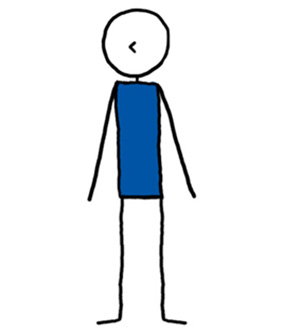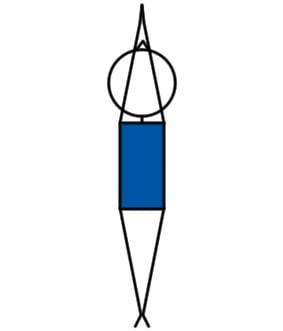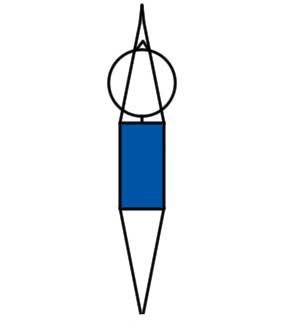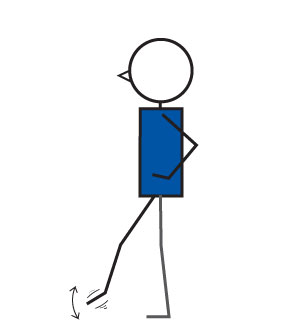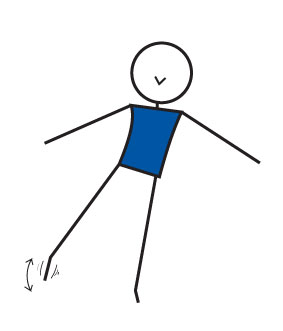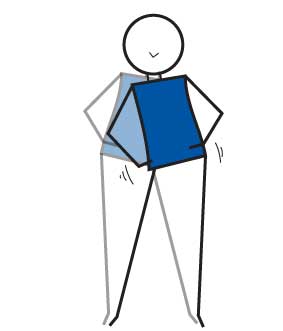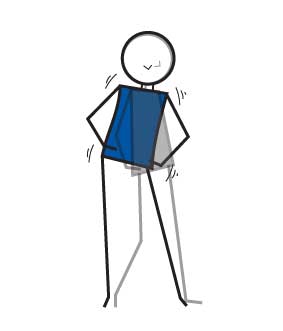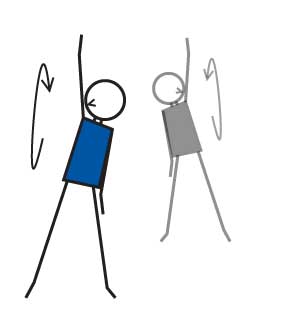
| Category: | Yoga Lesson Planner |
|---|---|
| Sub Category: | Dru |
| Types: | Chest Opener, Standing, Stretch, Twist |
| Anatomy: | Arms & Shoulders, Core, Hamstrings, Hips, Lower Back, Middle Back, Neck, Psoas |
| Chakras: | Base, Sacral Centre |
| Therapy: | Anxiety, Leg Congestion, Poor Posture, Stress, Varicose Veins |
| Drishti: | Tip Of Nose |
| Dosha: | Kapha, Pitta |
Stand with hands on hips. Hips shoulder width apart. Make figure of eights by moving one hip forward and back, moving from side to side. Loosen through the thoracic spine (upper back and abdomen area). Bring elbows and shoulders into the movement. Now step it out. Arms reach up (stretch all the way up to fingertips). Open chest and feel energy flow through you.
Releases tension in the hips and thoracic spine.
Click here for lots of FREE downloadable Yoga lesson plans.
Click here for lots of FREE downloadable Pilates lesson plans.
Discovering Balance and Harmony with Dru Yoga
Introduction
In a world filled with the hustle and bustle of daily life, finding moments of peace, balance, and inner harmony can seem like an elusive dream.
However, the ancient practice of Dru Yoga offers a pathway to achieving just that. Rooted in the rich traditions of yoga and influenced by the gentle flow of Tai Chi, Dru Yoga is a holistic approach to wellness that nurtures the body, mind, and spirit.
In this blog post, we will explore the essence of Dru Yoga, its history, principles, benefits, and how it can transform your life.
The Origins and Philosophy of Dru Yoga
A. The Roots of Dru Yoga
Dru Yoga, also known as Dru, originated in ancient India, tracing its roots back over 2,000 years. The word “Dru” is derived from the Sanskrit word “Dhruva,” which means “still” or “unwavering.” This essence of stability and tranquillity is at the core of Dru Yoga’s philosophy.
While yoga is often associated with rigorous physical postures, Dru Yoga takes a more gentle and flowing approach. It integrates elements of traditional Hatha Yoga, such as asanas (physical postures) and pranayama (breath control), with the graceful movements of Tai Chi. This unique blend creates a practice that emphasizes fluidity, relaxation, and inner strength.
B. The Philosophy of Dru Yoga
Dru Yoga is grounded in the belief that every individual possesses an inner source of calm and wisdom. The practice aims to awaken this inner potential, allowing individuals to lead a more balanced and harmonious life. It encourages self-acceptance, self-love, and self-realization.
Central to Dru Yoga philosophy are the five elements: Earth, Water, Fire, Air, and Ether. These elements are not just physical substances but represent different qualities and energies within us. Practising Dru Yoga helps to balance these elements within ourselves, promoting overall well-being.
Principles of Dru Yoga
A. Energy Block Release Sequences
One of the unique aspects of Dru Yoga is the use of Energy Block Release (EBR) sequences. These sequences are a series of flowing movements and stretches designed to release physical and emotional tension held within the body. EBRs are particularly effective in addressing stiffness, stress, and emotional blockages.
EBRs are performed with focused awareness of the breath, allowing practitioners to let go of tension and create space for positive energy to flow. These sequences serve as a powerful tool for enhancing flexibility and releasing pent-up emotions, promoting a sense of lightness and vitality.
B. The Power of Visualization
Dru Yoga places great importance on the power of visualization. Visualization techniques are used to guide practitioners into a state of deep relaxation and heightened awareness. Through guided imagery, individuals can explore their inner world, connect with their inner wisdom, and set positive intentions for their lives.
Visualizations in Dru Yoga often involve imagery from nature, such as flowing rivers, serene lakes, or majestic mountains. These natural elements serve as metaphors for the qualities and energies one seeks to cultivate within themselves. Visualization practices in Dru Yoga contribute to increased mental clarity, emotional stability, and a sense of inner peace.
Benefits of Dru Yoga
A. Physical Well-being
Improved Flexibility: Dru Yoga’s flowing movements and stretches gently improve flexibility and joint mobility.
Strengthened Core: Many Dru Yoga postures engage the core muscles, promoting strength and stability.
Pain Relief: Regular practice can help alleviate chronic pain conditions and muscular tension.
Better Posture: Awareness of body alignment in Dru Yoga helps in maintaining good posture in daily life.
B. Mental and Emotional Balance
Stress Reduction: Dru Yoga’s emphasis on relaxation and breath control reduces stress and anxiety.
Enhanced Emotional Resilience: The practice helps individuals process and release emotional blockages.
Improved Concentration: Visualization techniques enhance mental focus and concentration.
Increased Self-awareness: Practitioners gain a deeper understanding of their emotions and thought patterns.
C. Spiritual Growth
Inner Peace: Dru Yoga nurtures a sense of inner calm and tranquillity.
Self-Realization: It fosters self-discovery and a connection to one’s inner wisdom.
Spiritual Connection: The practice can deepen one’s spiritual connection and sense of purpose.
How to Get Started with Dru Yoga
A. Finding a Dru Yoga Class
If you’re interested in experiencing the benefits of Dru Yoga, the first step is to find a qualified Dru Yoga instructor or class. Look for instructors who are certified by reputable Dru Yoga organizations.
B. Equipment and Attire
Dru Yoga is a relatively low-impact practice, and you won’t need much equipment. A comfortable yoga mat, loose-fitting clothing, and perhaps a cushion or blanket for added comfort during relaxation are all you need to get started.
C. Start Slowly
If you’re new to yoga or have physical limitations, it’s essential to start slowly and listen to your body. Dru Yoga is suitable for individuals of all ages and fitness levels, and modifications can be made to accommodate various needs.
D. Consistency is Key
Like any form of yoga, consistency in practice is essential to experience the full benefits of Dru Yoga. Even a few minutes of daily practice can make a significant difference in your physical and mental well-being.
Incorporating Dru Yoga into Daily Life
Dru Yoga is not just a practice confined to the yoga mat; it’s a way of life. Here are some ways to incorporate its principles into your daily routine:
A. Morning Rituals: Start your day with a short Dru Yoga routine to set a positive tone for the day ahead.
B. Mindful Breathing: Practice conscious breathing throughout the day to reduce stress and stay grounded.
C. Visualization: Use the power of visualization to manifest your goals and dreams.
D. Stress Management: When faced with challenging situations, take a moment to breathe deeply and find your inner calm.
E. Evening Relaxation: Wind down in the evening with a relaxation practice to release tension and promote restful sleep.
Dru Yoga FAQs
What Is Dru Yoga?
Dru Yoga is a style of yoga that incorporates poses, fluid movement, pranayama (breathwork), relaxation, mudras (hand gestures), affirmations, and meditation.
I think of it as a mix between traditional Yoga and Tai Chi due to its dynamic, flowing movements.
It’s a gentle form of yoga suited for all types, but more attractive to people looking for a therapeutic and stress-busting form of yoga. Dru Yoga concentrates on keeping the joints relaxed and flexible, with fluid movements originating from the spine.
Energy Block Release sequences are used to release physical, mental and emotional tension through movement.
What Does The Word Dru Refer To?
The word “Dru” refers to Dhruva, a prince in Hindu mythology whom the god Vishnu honoured with the eternal abode on the Pole Star. Dru can also be translated from Sanskrit as ‘north star’ which symbolises our “inner still-point”.
Is Dru Yoga Inspired By The Teachings Of Francis Of Assisi And Mahatma Gandhi?
Yes. The association with Francis Of Assisi and Mahatma Gandhi is probably why this type of Yoga attracts people looking for a Yoga practice that is a little more spiritual than a traditional, more exercise-focused practice.
What Poses Can You Expect At A Dru Yoga Class?
You can expect lots of mantras, mudras, pranayama (breath-work), and Dru yoga poses such as down lunge pose, foot-shaking pose, high lunge pose, hip circles pose, hip figure of eight pose, horizontal lunge, mountain to high lunge pose, wrist shaking, and traditional yoga poses such as bridge pose, downward facing dog pose, eagle pose, and cobra pose. Sun Salutation (Surya Namaskara) is also popular.
Why Is Dru Yoga Considered More Therapeutic Than A Traditional Yoga Class?
Dru yoga is probably considered a bit more therapeutic than a traditional yoga class because it tends to focus on positive transformation through rebalancing the “chakras” (the body’s subtle energy systems) and the “koshas”, which include our thoughts, feelings and our inner self.
Why Is Dru Yoga Considered One Of The Most Accessible Styles Of Yoga?
Dru yoga is considered one of the most accessible styles of yoga because of its flowing, gentle, tai-chi nature. Also, it draws on input from osteopaths, and physiotherapists.
What Is The Still-Point In Dru Yoga?
When practising Dru Yoga the aim is to arrive at the “still-point” which is the fifth kosha, our bliss layer, known as Anandamaya Kosha (the 5th Kosha).
What Are The 5 Koshas?
A kosha is a covering of the “Atman”, or “Self” according to Vedantic philosophy. There are five koshas, and they are often visualised as the layers of an onion in the subtle body.
The five Koshas are:
Annamaya kosha = the physical body
Pranamaya kosha = the energy (breath)
Vijnanamaya kosha = the thoughts & beliefs
Manomaya kosha = the feelings and emotions
Anandamaya kosha = the still-point (joy & bliss)
What Are The Seven Dru Energy Block Release (EBR) Sequences?
The seven Dru Energy Block Release (EBR) sequences combine conscious breathing, observing thoughts and feelings while flowing through a yoga practice, and introducing positive affirmations and visualisations so we can remove energy blocks and restore inner balance.
Is Dru Yoga An Outdoor Yoga Style?
It’s the one style of yoga that tends to be more “outside” than traditional yoga due to the emphasis on mother nature.
One of the popular Dru sequences is a salutation to the earth, which is often taken outside so that practitioners can tune into all their senses; tasting the air, hearing the sounds, feeling the wind on their face, touching the ground with their bare feet, inhaling the scents, and taking in the scene with your eyes.
Conclusion
In a world filled with constant demands and distractions, Dru Yoga offers a path to rediscovering balance, harmony, and inner peace. This ancient practice, rooted in the wisdom of yoga and the grace of Tai Chi, provides a holistic approach to well-being that nurtures the body, mind, and spirit.
By adding the principles of Dru Yoga into your life, you can experience improved physical health, mental and emotional balance, and a deeper connection to your inner wisdom.
So, why not embark on a journey of self-discovery and transformation through the gentle, flowing practice of Dru Yoga? Your path to a more harmonious and balanced life awaits.




 Yoga Lesson Planner
Yoga Lesson Planner
 Pilates Lesson Planner
Pilates Lesson Planner
